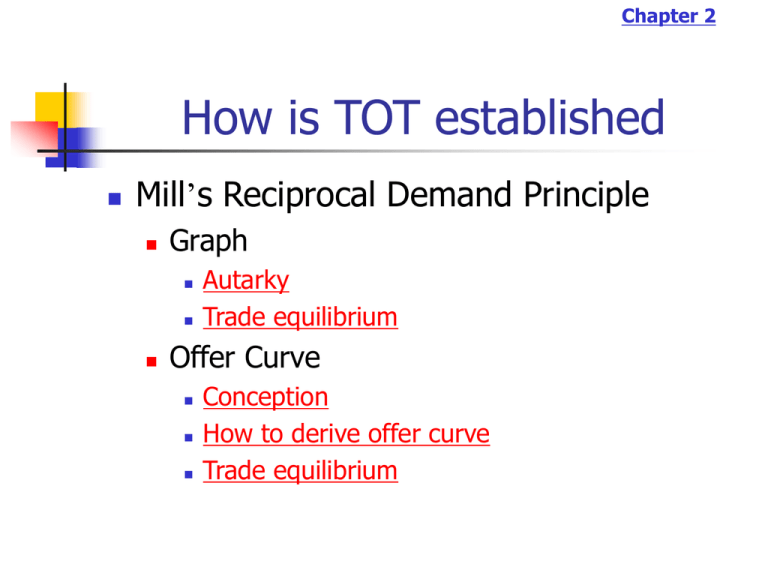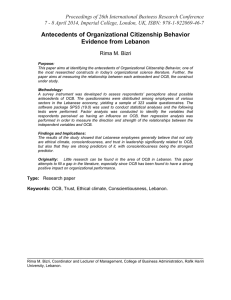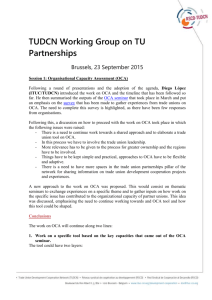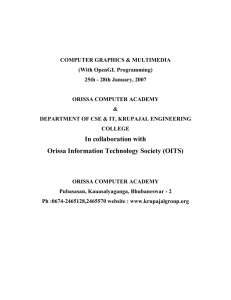Chapter 2
advertisement

Chapter 2 How is TOT established Mill’s Reciprocal Demand Principle Graph Autarky Trade equilibrium Offer Curve Conception How to derive offer curve Trade equilibrium Chapter 2 Autarky Price Line Y A K Y0 I2 I0 O X0 B X I1 Chapter 2 Trade Equilibrium Chapter 2 Offer Curves are all combinations of a country’s desired exports and imports at different terms of trade also known as reciprocal demand curves (J.S. Mills) measures of willingness to trade Chapter 2 Y Y1 Y2 Y C P (PX/PY)1 X1 X2 X (PX/PY)1 Y5 X5 X Chapter 2 Y Y3 (PX/PY)1 Y4 (PX/PY)2 Y X3 X4 X (PX/PY)2 (PX/PY)1 Y6 Y5 X5 X6 X Chapter 2 Y Y3 (PX/PY)1 Y4 (PX/PY)2 Y X3 OCA X4 X (PX/PY)2 (PX/PY)1 Y6 Y5 X5 X6 X Chapter 2 Offer Curves Offer curves represent willingness to trade at every possible terms of trade As the relative price of good X rises, Country A becomes willing to export more and import more Offer curves “bow” towards the import good axis Chapter 2 Deriving Country B’s Offer Curve This will reflect Country B’s willingness to trade at different terms of trade B’s offer curve bows towards the axis with B’s import good on it Chapter 2 Y (PX/PY)1 p Y7 c Y8 Y X7 X8 X (PX/PY)1 Y9 X9 X Chapter 2 Y (PX/PY)1 Y10 (PX/PY)2 Y11 Y X10 X11 X (PX/PY)1 (PX/PY)2 OCB Y12 Y9 X9 X12 X Chapter 2 Terms of Trade Equilibrium The international terms of trade (that is, PX/PY) will be the slope of a line passing through the point where the offer curves cross. This equilibrium point takes into account demand and supply conditions in both countries Chapter 2 Terms of Trade Equilibrium Y OCA (PX/PY)E OCB If these are the terms of trade, country A will desire to export X1 units, and country B will want to import X1 units; Y1 X1 country A will desire to import Y1 units, and country B will want to export Y1 units X Chapter 2 How Do We Know It’s Equilibrium? Any terms of trade other than (PX/PY)E will result in excess demand for one good excess supply for the other Therefore relative prices will adjust until (PX/PY)E is reached Chapter 2 Disequilibrium Y OCA (PX/PY)1 Y1 Y2 OCB At (PX/PY)1, country A wishes to import Y1 units, but country B is only interested in exporting Y2 units. That is, there is an excess demand for good Y. X Chapter 2 Disequilibrium OCA Y (PX/PY)1 OCB At (PX/PY)1, country A wishes to export X1 units, but country B is only interested in importing X2 units. That is, there is an excess supply of good X. X2 X1 X Chapter 2 Disequilibrium Excess demand for Y causes PY to rise Excess supply of X causes PX to fall Thus, (PX/PY) falls In other words, the terms of trade line gets flatter, moving the countries in the direction of equilibrium Chapter 2 Moving Towards Equilibrium Y (PX/PY)1 OCA OCB X Chapter 2 Disequilibrium Terms of trade lines that are flatter than (PX/PY)E, such as Y OCA (PX/PY)2 OCB X Chapter 2 Disequilibrium Terms of trade lines that are flatter than (PX/PY)E will results in an excess demand for good X an excess supply of good Y, and so (PX/PY) will rise That is, the terms of trade line will get steeper until (PX/PY)E is reached Chapter 2 Moving Towards Equilibrium Y (PX/PY)2 OCA OCB X











